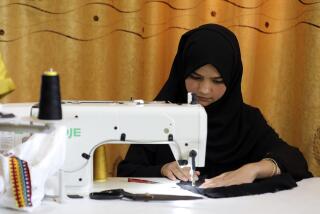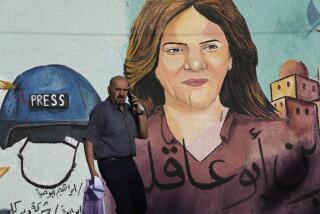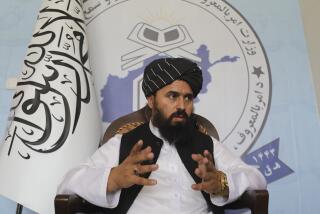Afghanistan’s Female Pioneers in Print
- Share via
KABUL, Afghanistan — In the mornings, Marry Nabard Aaeen sits in a dim room with fellow female reporters, separated from the male journalists of the government-run Bakhtar news agency by a heavy curtain and a closed door.
She’s relegated to “women’s articles” on health, food, culture and children.
In the afternoons, Aaeen sits in a different room with other female reporters, but she’s in charge. In this room, she’s the editor of Seerat, which calls itself Afghanistan’s first independent weekly newspaper run by women for women.
The room is the size of a storage closet--actually, it is a storage closet. In its tiny confines, Aaeen directs coverage of women’s interest stories, but she also sends her reporters out to cover the “men’s turf” of Afghanistan: politics, drugs, government, crime and controversial social issues.
In mid-December, barely a month after the fall of the Taliban here in Kabul, the capital, Aaeen and four other women created Seerat as a one-page weekly. Late last month, Seerat published its 13th issue, a comparatively fat edition with four printed pages and a publication run of 1,000.
The women launched Seerat after getting back their old jobs at Bakhtar, which the Taliban had taken away in the mid-1990s. Although they were gratified to have their jobs back, the women said, they felt constrained by their second-class status at the male-dominated news agency.
At Bakhtar, the women rarely are permitted to venture out on assignments, and the men, seen as the breadwinners, end up with bigger paychecks because they’re allowed to work longer hours.
Pooling their money, the women started writing their own articles in the afternoons. They paid a private printing company to run off 500 copies of a one-page newsletter, complete with cartoons and editorials. They had no computers or typewriters; they still write their articles longhand.
The cost of Seerat is 1,000 afghanis, or about three cents (foreigners pay $1). In part because the paper fails to publish some weeks, circulation has been unsteady, ranging from 100 to 500 paid copies per issue.
“It’s still hard to attract readers because their curiosity, their intelligence, has been worn away by all the years under the Taliban,” said Aaeen, a 38-year-old who favors long, stylish dresses that cover her arms and legs but are a far cry from the burkas that the Taliban forced women to wear in public.
Seerat has attitude. Aaeen recently wrote a blistering editorial demanding that women stop sitting in the back of buses and taxicabs or, in some cases, in open taxi trunks. Another article pointed out that administrations before the Taliban provided day care for female government employees, while the new government does not.
Some interviews are tough. Afghans whose family members were killed during the U.S.-led campaign that drove the Taliban from Kabul angrily chased the Seerat reporters from their homes a few weeks ago, the women said.
Riding the bus last week, Aaeen struck up a conversation with a woman who mentioned that her daughter, a newlywed, was killed in a U.S. airstrike last fall. The woman pulled out her daughter’s photo and began weeping.
Aaeen asked the woman to lend her the photo and to meet her for an interview. The woman refused, saying her husband would never give her permission.
“We have a long way to go before Afghanistan is a modern country,” Aaeen said. “That’s what Seerat is trying to achieve. We want the women of Afghanistan to be more modern, more educated, more in control of their lives.”
Though Seerat promotes what Aaeen calls “progressive ideas,” she said it also seeks to inform and entertain women. “Their lives have been terrible not just under the Taliban, but under 23 years of war,” she said.
Aaeen despised the burka. She said she ripped it off Nov. 13, the day the Taliban began fleeing Kabul. Aaeen, a mother of four, taught an illegal girls school in her home during the Taliban era.
In the Seerat office, a blue burka lies on a mattress on the floor. It belongs to Najeeba Maraam, a reporter who doubles as the weekly’s treasurer. Maraam said she wears the suffocating garment to and from work because she passes through conservative neighborhoods, including her own.
At the office, she changes into a long-sleeved blouse and long dress. She puts on makeup and lipstick. And, like the other four staffers, she wears a dark scarf that covers her hair.
“I’m still a little afraid people will cause problems for me,” Maraam said. “People’s attitudes have not entirely changed just because the Taliban is gone.”
Among other exposes, the weekly has published articles on the miserable conditions for returning Afghan refugees, and one condemning the corruption and profiteering in the nation’s lucrative opium trade.
Rukhshana Alawee, 35, an aggressive reporter and mother of four, said there are few stories women can’t cover as well as men, despite working in a society in which women are often treated as chattel and men dominate public life. Only a small percentage of women mix with men in public, and very few appear without burkas, even in Kabul. In most homes, women serve the men meals and eat alone later.
“We interview ministers, lawyers, doctors--all men,” Alawee said. “Men are used to women reporters. There is a long tradition of women journalists here. The men are very polite to us ladies.”
The women say their husbands are supportive and “modern.” Aaeen’s husband is a judge. Alawee and Maraam are married to engineers. Each woman has a university journalism degree.
Alexandre Plichon, a French journalist who heads the private agency that helps fund Seerat, said the women need guidance in newspaper production and distribution. “But as journalists,” he said, “they’re very competent.”
Plichon’s agency, Aina, which promotes independent reporting in Afghanistan, pays the weekly’s salaries and other costs through grants from the U.S. Agency for International Development and the British and French governments, he said.
The women said they have been paid once in the last three months for their government work at Bakhtar. They earn about $50 a month, they said, but they were paid just $38 in March. At Seerat, they said, Aaeen is paid $150 a month as editor, and her reporters earn $100 to $150.
As a commentary on a government that rarely pays its employees, Seerat ran a cartoon showing a worker shouting down at a penniless colleague who had just died and was being buried: “Get up! The government’s going to start paying salaries any day now!”
The paper also ran an anti-burka cartoon about a little boy and his female teacher. It defies translation, but the punch line refers to “big blue tents.” The reporters said it was a hit with female readers.
Also popular are the paper’s traditional service features on such subjects as keeping children clean and healthy in summertime, and the importance of adding fruits and vegetables to the heavily meat-and-starch Afghan diet.
But news drives the paper. The day the country’s former monarch, Mohammad Zaher Shah, arrived after 29 years in exile, Alawee was in the middle of the scrum of Western and Afghan reporters, male and female, pushing and shoving at the airport to catch a glimpse. She followed her report on his arrival with an analysis of his impact on the country’s fragile political equilibrium.
For an upcoming issue, Aaeen said, she’s working on a new expose: why the new government, even with the Taliban gone, still refuses to play the music of female singers and musicians on government-run TV and radio.
“That’s an inequity that really makes me angry,” Aaeen said. She thought for a moment, then added, “But we’re not sacrificing news coverage to run this story. If a hot story is breaking, you can be sure we’ll be right on it.”
More to Read
Sign up for Essential California
The most important California stories and recommendations in your inbox every morning.
You may occasionally receive promotional content from the Los Angeles Times.











